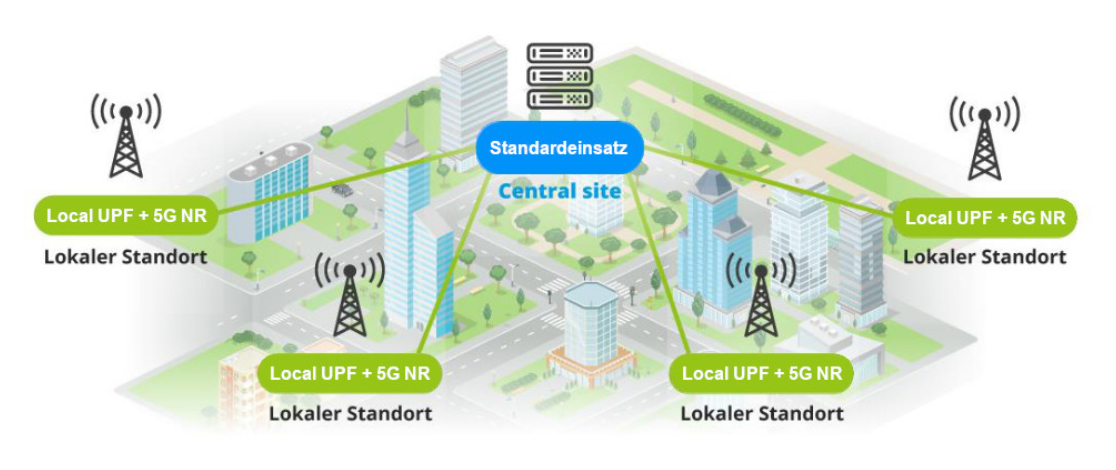The architecture of 5G radio networks offers interesting innovations. (Picture: David Mark, Gerd Altmann / Pixabay)
Ask about the benefits of 5G, and the first keywords that come to mind are eMBB, uRLLC and mMTC. But the innovative network architecture behind the campus network base stations also makes a big difference. CUPS and UPF are essential in increasing the network’s performance capabilities – especially for distributed sites.
In Germany, the range at 3.7 GHz is reserved for campus networks, and other countries have made similar arrangements. This allows companies to use exclusive spectrum for a private network with little effort, for example to network machines in production or to control autonomous transport robots on company premises.
The number of 5G campus networks is increasing slowly but steadily. The German Federal Network Agency (BNetzA) has already issued 243 licenses by September 15, 2022, and more are pending.
4G offers only limited functions
At the very beginning of the licensing process, 5G-capable components such as routers or modems were hard to come by. The advice at the time was to start with 4G/LTE first to gain experience and then upgrade later. In the meantime, there are more and more 5G industrial routers (see overview here), so it is no longer necessary to fall back on previous technologies.
That would also be fatal. This is because part of the 5G functionality is directly linked to the network architecture, and there are crucial differences between 4G and 5G in the area of radio access networks (Next Generation Radio Access Network, NG-RAN). It is only since 5G that Next Generation Node Basestations (gNBs) can be divided into a Central Unit (CU) and other Distributed Units (DU).
This division is called Control/User Plane Separation (CUPS) and ultimately leads to a complete separation of the control plane and the user plane. The control plane is responsible for functions such as managing the user connection, defining QoS policies or user authentication, while the user plane is responsible for transporting the data. The separation of the two functional areas has a decisive advantage: they can be scaled independently of each other.
Control plane processing (CU-CP) corresponds to the complexity of the network, while user plane processing (CU-UP) corresponds to the amount of data traffic. Thus, in a network, as data throughput increases, the user plane can be adjusted without having to change the control plane.
UPF – an essential core element
The user plane is controlled via the User Plane Function (UPF), a functional layer of the 5G core network. It is primarily responsible for routing and forwarding, inspection and QoS handling of data packets The ability to split the user plane into centralized and distributed user planes (CU/DU) offers interesting possibilities for the network architecture. For example, a campus network that spans multiple buildings and/or open spaces can be separated into independent subnets, each using its own base stations, thus ensuring high bandwidth and low latency in each subarea.
At the same time, the network functions of the control level are available centrally. They therefore only need to be set up and maintained once for the entire network, which greatly simplifies network and data management.
This can also be used by companies that want to efficiently connect several branches. In Taiwan, for example, a nursing home has integrated various sites into a shared 5G private network – each with its own local radio networks, but a central control layer. The white paper from network specialist QCT shows the advantages this offers.
Spoilt for choice
UPF are offered by several manufacturers, either as an integrable software component or as part of a complete 5G standalone core. Of course, all system suppliers – such as Nokia, Ericsson, Huawei, ZTE or Samsung – each offer their own 5G cores including UPF. Mobile network providers sometimes use the offerings of their main suppliers. Vodafone, for example, uses the Ericsson 5G core. In some cases, however, providers also use third-party or in-house developments. Deutsche Telekom, for example, announced that it will soon be installing a 5G core network developed jointly with Mavenir.
Thanks to OpenRAN, however, private network operators can also fall back on alternative UPFs. Quite a few can be found in the Intel OpenRAN ecosystem. including QCT, Cisco, Juniper Networks and Rakuten Symphony. They offer both OpenRAN hardware components, as well as software components like the UPF. So users have a wide range of offerings from which to choose.
Our white paper “5G brings innovation to network architecture” tells you which options UPF offers and what you should look out for when making your decision:
Download Whitepaper 5G brings innovation to network architecture










Leave A Comment